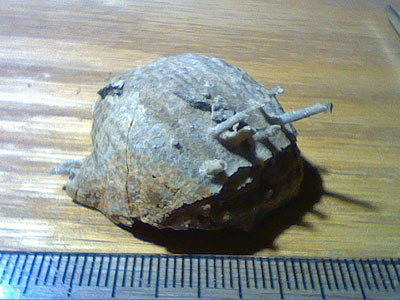|
Brachiopods
are a minor faunal element in the Fort Apache Limestones, nearly
100% were found as Productids and their hordes of tiny spines.
Only ONE other brach was found, and it was microscopic in size
at a size of 1 mm. No doubt the large amount of mud and silt
raining down on the bottom of the Fort Apache Sea made life very
difficult for any type of filter feeders. Largely missing as
well are corals, crinoids and sponges which also feed by filtering
the muddy waters. Only the Productids seemed to be adapted to
such conditions.
Both silicified
and calcified fossils were found. Some of the silicified fossils
were very delicate and had many of the spines still attached
when dissolved out of the limestones with muriatic acid. Winters
in his monumental GSA memoir 89 identifies the productids as
Bellaclathrus spinosus, and the tiny brach as Pseudodielasma
sp. Since this is a very generic looking brachiopod, well go
with his identification.
 | Pseudodielasma
sp. top view, pedical valve. This brach is the size of a pinhead
and is the only one found after processing over 200 pounds in
limestones! 45x |
 | Pseudodielasma
sp. bottom view, brachial valve. Here you can see the opening
at the top for the pedicle to emerge for external support on
a hard substrate. 45x |
 |
Bellaclathrus
spinosus, only about an inch across it is far smaller than the
average size of the productids found in the overlying Permian
Kaibab formation. This one is calcified on the surface of the
limestone found by cracking open large rocks. 2x |
 |
Bellaclathrus
spinosus - two specimens. 2x |
 |
Bellaclathrus
spinosus - a really nice specimen showing the wings on the sides
of the umbo. 2x |
 |
Bellaclathrus
spinosus - very flat upper valve that is calcified. 3x |
 |
Bellaclathrus
spinosus - Silicified specimen shows some of the spines still
attached. 2x |
 |
Bellaclathrus
spinosus - top valve seen here attached to basal valve with spines.
The valves of brachiopods normally do not separate when they
are empty. 2x |
 |
Bellaclathrus
spinosus - nice shot of the spines. 2x |
 |
Bellaclathrus
spinosus - Silicified specimens show much external detail. But
they are hollow and very delicate! Notice the spine coming off
the wings. 2x |
 |
Bellaclathrus
spinosus - other side. 2x |
 |
Bellaclathrus
spinosus - two spines on the valve wings. 3x |
 |
Bellaclathrus
spinosus - We found hordes of loose productid spines in the limestones.
7x |
 |
Bellaclathrus
spinosus - Close up at 20x of some of the spines. Most are hollow
tubes, and never come to a point. In life they are filled with
live tissue and the spines grow by adding on to the ends. |
 |
Bellaclathrus
spinosus - Two spines on a common base which was once the outermost
layers in the productid shell. 20x. |
|

